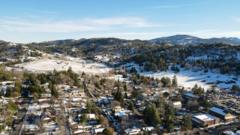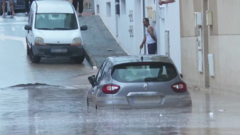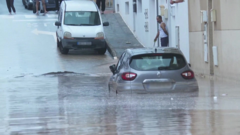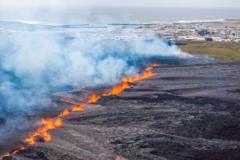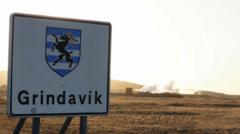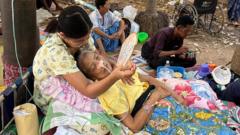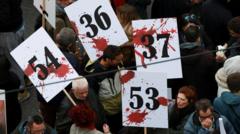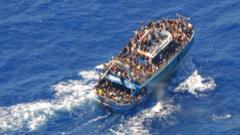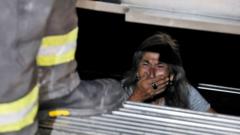Santorini is currently facing an unprecedented seismic crisis, with a significant increase in earthquake activity prompting many residents to evacuate. Scientists are puzzled by the unusual patterns, while local officials prepare for possible future quakes.**
Unprecedented Seismic Activity on Santorini: Understanding the Ongoing Crisis**
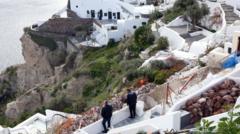
Unprecedented Seismic Activity on Santorini: Understanding the Ongoing Crisis**
Thousands of earthquakes have shaken the Greek island of Santorini, leading to widespread evacuations and a state of emergency. Experts analyze the causes and potential duration of this unusual seismic event.**
The picturesque Greek island of Santorini is under unusual stress due to a swarm of seismic activity that has left residents grappling with uncertainty. "We've put all our mattresses in the living room," laments Georgia Nomikou, reflecting the anxiety permeating the island as thousands of earthquakes have taken place over the past week. Once a serene tourist destination known for its stunning views, Santorini's tranquility has been disrupted as about 75% of its 15,000 residents have evacuated since authorities declared a state of emergency following a 5.2 magnitude earthquake—the strongest among the recent disturbances.
Experts are calling this seismic event "unprecedented," with Dr. Athanassios Ganas from the National Observatory of Athens noting that the current seismic swarm does not correlate with typical earthquake patterns. Unlike traditional sequences where a major quake is followed by aftershocks, Santorini's tremors are occurring without a clear mainshock. "We have never seen something like this before in modern times in Greece," Dr. Ganas stated. The island is part of the Hellenic Volcanic Arc, but despite its history as a volcanic region, it has not seen significant eruptions since the 1950s, leaving researchers puzzled about the underlying causes of this crisis.
In recent days, Santorini has experienced thousands of tremors. Dr. Margarita Segou of the British Geological Survey describes the quakes as occurring in daily "pulses," with heightened seismicity followed by periods of lower activity. The pressing question remains: how long will this seismic activity persist? While seismologists hope that the strongest quake experienced thus far might be the peak, experts caution that the activity may continue for weeks.
The ongoing seismic events raise concerns for the safety of the island's residents, with fears that these quakes could serve as precursors to larger seismic events. Professor Joanna Faure Walker from UCL's Institute of Disaster Risk Reduction notes that while some large earthquakes are preceded by foreshocks, the phenomena currently experienced are not categorized as volcanic—an important distinction given the island's geological history.
In response to the seismic threat, enhanced security and emergency services have been deployed ahead of any potential major quake. Local leaders, like Nomikou, remain cautious; many have packed emergency bags, preparing for swift evacuation if necessary. However, there are voices among the island’s population that remain unfazed by the seismic activity; resident Chantal Metakides asserts her confidence in her home’s resilience, stating that it has withstood quakes and eruptions for centuries.
As the scientific community strives to understand this unusual seismic crisis and provide insight into its duration and implications, the future of Santorini remains uncertain—caught between the beauty of its landscape and the tumult of geological forces at play.
Experts are calling this seismic event "unprecedented," with Dr. Athanassios Ganas from the National Observatory of Athens noting that the current seismic swarm does not correlate with typical earthquake patterns. Unlike traditional sequences where a major quake is followed by aftershocks, Santorini's tremors are occurring without a clear mainshock. "We have never seen something like this before in modern times in Greece," Dr. Ganas stated. The island is part of the Hellenic Volcanic Arc, but despite its history as a volcanic region, it has not seen significant eruptions since the 1950s, leaving researchers puzzled about the underlying causes of this crisis.
In recent days, Santorini has experienced thousands of tremors. Dr. Margarita Segou of the British Geological Survey describes the quakes as occurring in daily "pulses," with heightened seismicity followed by periods of lower activity. The pressing question remains: how long will this seismic activity persist? While seismologists hope that the strongest quake experienced thus far might be the peak, experts caution that the activity may continue for weeks.
The ongoing seismic events raise concerns for the safety of the island's residents, with fears that these quakes could serve as precursors to larger seismic events. Professor Joanna Faure Walker from UCL's Institute of Disaster Risk Reduction notes that while some large earthquakes are preceded by foreshocks, the phenomena currently experienced are not categorized as volcanic—an important distinction given the island's geological history.
In response to the seismic threat, enhanced security and emergency services have been deployed ahead of any potential major quake. Local leaders, like Nomikou, remain cautious; many have packed emergency bags, preparing for swift evacuation if necessary. However, there are voices among the island’s population that remain unfazed by the seismic activity; resident Chantal Metakides asserts her confidence in her home’s resilience, stating that it has withstood quakes and eruptions for centuries.
As the scientific community strives to understand this unusual seismic crisis and provide insight into its duration and implications, the future of Santorini remains uncertain—caught between the beauty of its landscape and the tumult of geological forces at play.

